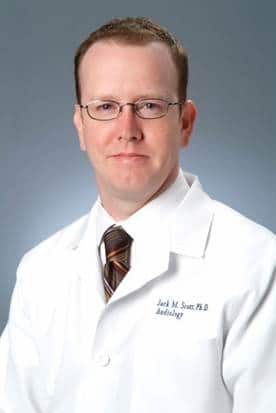LITTLE ROCK, ARKANSAS —New research at the University of Arkansas for Medical Sciences (UAMS) shows that while transparent masks and face shields aid in communication by restoring the visibility of the mouth and the lips, they muffle the sounds made by the speaker more than other masks do.
Samuel Atcherson, Ph.D., professor of Audiology in the College of Health Professions and professor of Otolaryngology-Head & Neck Surgery in the College of Medicine, and his team recently published their preliminary findings online in Audiology Today.
“As an audiologist, I want to ensure that communication doesn’t suffer during these times of universal masking. The deaf and hard of hearing community has always been at a disadvantage in the health care system because medical masks interfere with their ability to read lips. Now that disadvantage is everywhere.”
–Samuel Atcherson, Ph.D.

Samuel Atcherson, Ph.D.
Previous research by Atcherson and others showed that standard masks, both cloth and medical, present a visual barrier to those individuals who depend on nonverbal facial cues to aid in their communication. For example, a person with hearing loss may need to read lips to understand what is being said, especially in louder social settings.
In addition, masks and face shields muffle sounds. Atcherson and his team measured how much sound quality is reduced with various facial coverings. They found that a surgical mask muffles sound by 5 decibels; N95 masks muffle sound between 8.7-10.9 decibels; commercially available transparent masks muffle sound between 12-13.3 decibels; and homemade transparent cloth masks reduce sounds by 21.1 decibels.
Facial shields further decrease the sounds, Atcherson said, noting a total reduced sound quality of between 20-29.2 decibels, depending on the mask used with a shield.
Hearing Loss and Masks
“This is a concerning development,” Atcherson said. “Because of the muffling effect, a normal hearing person communicating with someone wearing a transparent mask and a face shield would mimic a mild hearing loss. For people who already suffer from hearing loss, their communication could be greatly affected by the reduced quality of sound.”
Transparent masks aren’t bad, he said, they’re just not a perfect solution.
“I don’t want to shoot myself in the foot because the work we have been doing shows communication improves for everyone when you can supplement it with facial cues,” he said. “What I’ve found is not all transparent masks are created equal. The materials used and the distance of the film from the mouth seems to be the key – the closer it is, the more it muffles sound.
“I hope manufacturers will keep this data in mind when creating their masks.”
–Samuel Atcherson, Ph.D.
Atcherson said health care providers and educators especially need to be mindful of masks’ limitations and use additional strategies for helping improve communication. This could include a microphone for a lecturing teacher or pen and paper for a health care provider in a noisy clinic. There are also smartphone apps using automatic speech detection with reasonably good accuracy.
“With face masks being a part of our lives for the near future, we need to understand how they affect our speech and make adjustments for that,” Atcherson said. “As this pandemic has left so many of us feeling isolated, communication is more important than ever.”
About University of Arkansas for Medical Sciences
UAMS is the state’s only health sciences university, with colleges of Medicine, Nursing, Pharmacy, Health Professions and Public Health; a graduate school; hospital; a main campus in Little Rock; a Northwest Arkansas regional campus in Fayetteville; a statewide network of regional campuses; and seven institutes: the Winthrop P. Rockefeller Cancer Institute, Jackson T. Stephens Spine & Neurosciences Institute, Harvey & Bernice Jones Eye Institute, Psychiatric Research Institute, Donald W. Reynolds Institute on Aging, Translational Research Institute and Institute for Digital Health & Innovation. UAMS includes UAMS Health, a statewide health system that encompasses all of UAMS’ clinical enterprise including its hospital, regional clinics and clinics it operates or staffs in cooperation with other providers. UAMS is the only adult Level 1 trauma center in the state. U.S. News & World Report named UAMS Medical Center the state’s Best Hospital; ranked its ear, nose and throat program among the top 50 nationwide; and named six areas as high performing — cancer, colon cancer surgery, heart failure, hip replacement, knee replacement and lung cancer surgery. UAMS has 2,727 students, 870 medical residents and five dental residents. It is the state’s largest public employer with more than 10,000 employees, including 1,200 physicians who provide care to patients at UAMS, its regional campuses, Arkansas Childrens Hospital, the VA Medical Center and Baptist Health.
Source: Yavonda Chase, UAMS








Samuel Atcherson, PhD: Have you or anyone you know, done any studies of the frequency response using a KEMAR with an artificial mouth ?: